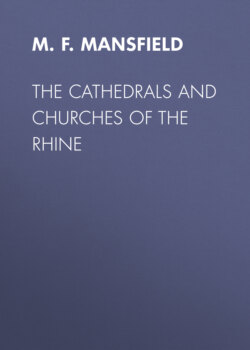Читать книгу The Cathedrals and Churches of the Rhine - M. F. Mansfield - Страница 4
На сайте Литреса книга снята с продажи.
ОглавлениеGENERAL VIEW of LEYDEN
In so far as this book deals only with the churches and cathedrals of the Rhine, and follows the course of the Neder Rijn and the Oud Rijn through Holland, there are but three Dutch cities which bring themselves naturally into line: Arnheim, Utrecht, and Leyden.
So far as Americans are concerned, there is a warm spot in their hearts for Old Holland, when they remember the brave little band of Pilgrims who gathered at Leyden and set sail from Delfthaven for their new home across the seas. This was but three hundred years ago, which, so far as the antiquity of European civilization goes, counts for but little. It is something, however, to realize that the mediæval architectural monuments of these places are the very ones which the Pilgrims themselves knew. It is true, however, that their outlook upon life was too austere to have allowed them to absorb any great amount of the artistic expression of the Dutch, but they must unquestionably have been impressed with the general appropriateness of the architecture around them.
Below Düsseldorf the topography and architectural features alike change rapidly, and the true Rhenish architecture of heavy arches, with an occasional sprinkling of fairy-like Gothic, really begins. Neuss, Essen, and all the Westphalian group of solidly built münsters speak volumes for German mediæval church architecture, while up the Rhine, past Düsseldorf, Cologne, Bonn, Königswater, Remagen, Sinzig, Andernach, Coblenz, and all the way to Mayence, and on past Schaffhausen to Basel are at least three score of interesting old churches as far different from those elsewhere as could possibly be imagined, and yet all so like, one to another, that they are of a species by themselves; all except the cathedral at Cologne, which follows the best practice of the French, except that its nave is absurdly short for its great breadth, and that its ponderous towers stand quite alone in their class.
In general, then, the cathedrals and churches of the Rhine form a wonderful collection of masterpieces of architectural art with which most well-informed folk in the world to-day should have a desire for acquaintanceship.
These often austere edifices, when seen near by, may not appeal to the popular fancy as do those of France and England, and they may not even have the power to so appeal; but, such as they are, they are quite as worthy of serious consideration and ardent admiration as any structures of their kind in existence, and they have, in addition, an environment which should make a journey among them, along the banks of the Rhine from its source to the sea, one of the most enjoyable experiences of life.
The Rhine loses none of its charms by intimate acquaintance; its history and legends stand out with even more prominence; and the quaint architectural forms of its cities are at least characteristically convincing.
Remains of every period may be found by the antiquary, from the time when the Roman eagle was triumphant throughout the dominion of the Franks to feudal and warlike times nearer our own day.
In addition, there are ever to be found evidences of the frugality and thrift of the Germans which preserve the best traditions of other days.
The love of the Rhineland in the breast of the Teuton is an indescribable sentiment; a confusion of the higher and lower emotions. It is characteristic of the national genius. We have been told, and rightly: "You cannot paint the Rhine, you cannot even describe it, for picture or poem would leave out half of the whole delicious confusion. The Rhine, however, can be set to music," and that apparently is just what has been done.
Everywhere one hears the music of the fatherland. Whether it is the songs and madrigals of the Church, or of the German bands in the Volksgarten, it is always the same, a light, irrepressible emotion which does much toward elucidating the complex German character.
Nowhere more than at Cologne is this contrast apparent. It is the most delightful of all Rhine cities. Usually tourists go there, or are sent there—which is about what it amounts to in most cases—in order to begin their "Rhine tour."
Before they start up-stream, they stroll about the city, pop in and out of its glorious cathedral, and perhaps one or another of its magnificent churches—if they happen to be on their line of march to or from some widely separated points—make the usual purchase of real eau de Cologne—though doubtless they are deceived into buying a poor imitation—and wind up in a river-side concert-garden, with much music and beer-drinking in the open.
This is all proper enough, but this book does not aim at recounting a round of these delights. It deals, if not with the Teutonic emotions themselves, at least with the expression of them in the magnificent and picturesquely disposed churches of both banks of the Rhine, from its source to the sea.
